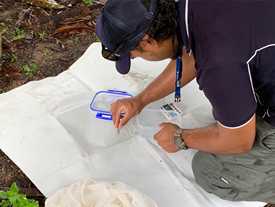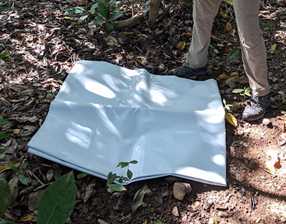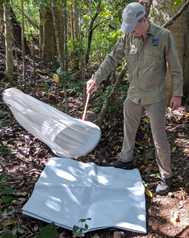Standard Operating Procedure for performing sweep net sampling of host-seeking mosquitoes
Tanya L L Russell, Kyran Staunton, Thomas R Burkot
Disclaimer
This Standard Operating Procedure may be used for training and reference purposes. Users are responsible for ensuring any edits to this document are produced and approved in accordance with all relevant legal and ethical requirements governing the surveillance operation.
Abstract
This Standard Operating Procedure (SOP) outlines the materials and processes required to perform sweep net sampling of host-seeking adult mosquitoes.
Description: Sweet nets can be used to capture mosquitoes that are attracted to a host and are flying the immediate vicinity. Human-baited sweep netting involves simply walking into a mosquito harbourage site and waiting for the mosquitoes to come to you. This method is effective for species such as Aedes albopictus which are aggressive biters.
Target species and physiological states: Captures host-seeking adults of both sexes and many species. Note, that Aedes males are often captured as they congregate around hosts in search of female mates.
Entomological surveillance indicators: Adult vector occurrence, density as well as adult vector behaviour (human biting rate, biting time, biting location).
Advantage: The equipment and supplies are inexpensive and portable. The mosquitoes are capture before they have a chance to bite the host.
Disadvantage: This method is labour intensive and requires trained staff. There is a low risk that field staff may become infected with mosquito-borne diseases.
Sampling period: Sweep net collections are usually conducted for a standardised time period or a fixed number of sweeps. When sampling Aedes, collections are often standardized to 5 or 10 minutes or 30 to 50 sweeps per sampling station.
Data: Total number of host-seeking mosquitoes per sampling effort (by species and sex). When necessary, field data is merged with the results of subsequent laboratory analyses.
To watch a video of how to use sweep nets to sample host-seeking mosquitoes go to: https://youtu.be/F8aSAgkyyUs
Before start
Human ethics
Where human ethics approval is required and granted, participants performing sweep net collections of host-seeking mosquitoes will be recruited following standard informed consent procedures. The potential risks and benefits of mosquito sampling will be discussed verbally in the local language. It will be explained that participation in host-seeking mosquito collections could exposure them to potentially infectious mosquito bites. Collectors will wear topical repellent and long clothing to protect them from mosquito bites. If in a malarious area, collectors will be given anti-malarial drugs to prevent them from becoming infected with malaria.
Attachments
Steps
Sampling procedure
First, choose a method for standardising the collections: either a set number of sweeps (e.g. 100 sweep) or a set time period (e.g. 10 minutes).
Walk to the sampling station, situated in an area with cool shade and surrounded by vegetation where mosquitoes are likely to rest.
Stop periodically (e.g. every 10-20 sweeps) and quickly fold the end of the net so that the mosquitoes caught in the back of the net are unable to escape.
Collect the mosquitoes from inside the net by either:
Killing the mosquitoes:
i.Pre-treat the sweep net with an adulticide so that captured mosquitoes are knocked-down or killed.
ii.Place the folded section into a plastic bag with a ball of cotton wall socked in chloroform for 1 – 2 minutes.
iii.After mosquitoes have been knocked down, tip them into a small white container and transfer into a storage container using forceps

Keeping the mosquitoes alive:
i.Aspirate the mosquitoes directly from the inside of the sweep net using an oral aspirator.
Place the mosquitoes directly into collection cups.
Temporarily store the mosquitoes in labelled collection cups until processing and long-term storage.
For details on processing and storage see Tanya Russell, Kyran Staunton, Amanda Murphy, Thomas Burkot 2022. Standard operating procedures for mosquito vector surveillance, processing and storage. protocols.io https://dx.doi.org/10.17504/protocols.io.eq2lyn13qvx9/v3
Additional notes
If pre-treating the sweep net with an adulticide, ensure that the mosquitoes are not resistant to the active ingredient.* Wear long clothing covering the arms and legs to prevent mosquito bites.
- In heavily infested areas, the collector can also wear repellent to prevent mosquitoes from landing and attempting to feed.
- The sweep-net method is used in a variety of ways to sample a wide range of insects, some net designs and procedures might not be suitable for sampling host-seeking mosquitoes.



